Continuing from the last post that presented a summary of our itinerary and covering Days 01 to 07 of our 15 day trip to Japan in December 2022: here is Part 2 that covers Days 08 to 15. A key component of our itinerary in this second half was over our usage of the 5 Day Takayama-Hokuriku Tourist Pass. We needed it to cover our journey from Takayama back to Nagoya on Day 13, so had to arrange our itinerary and our visitation to the cities of Fukui, Toyama and Shirakawa-Go to fit the duration coverage. If you’re drawing upon the same 5 Day Takayama-Hokuriku Tourist Pass, you’d likely want to just use our below as a source of additional information, as there is a ton of things to do in the cities surrounding Kanazawa that we did not include this time – e.g. visits to onsens.
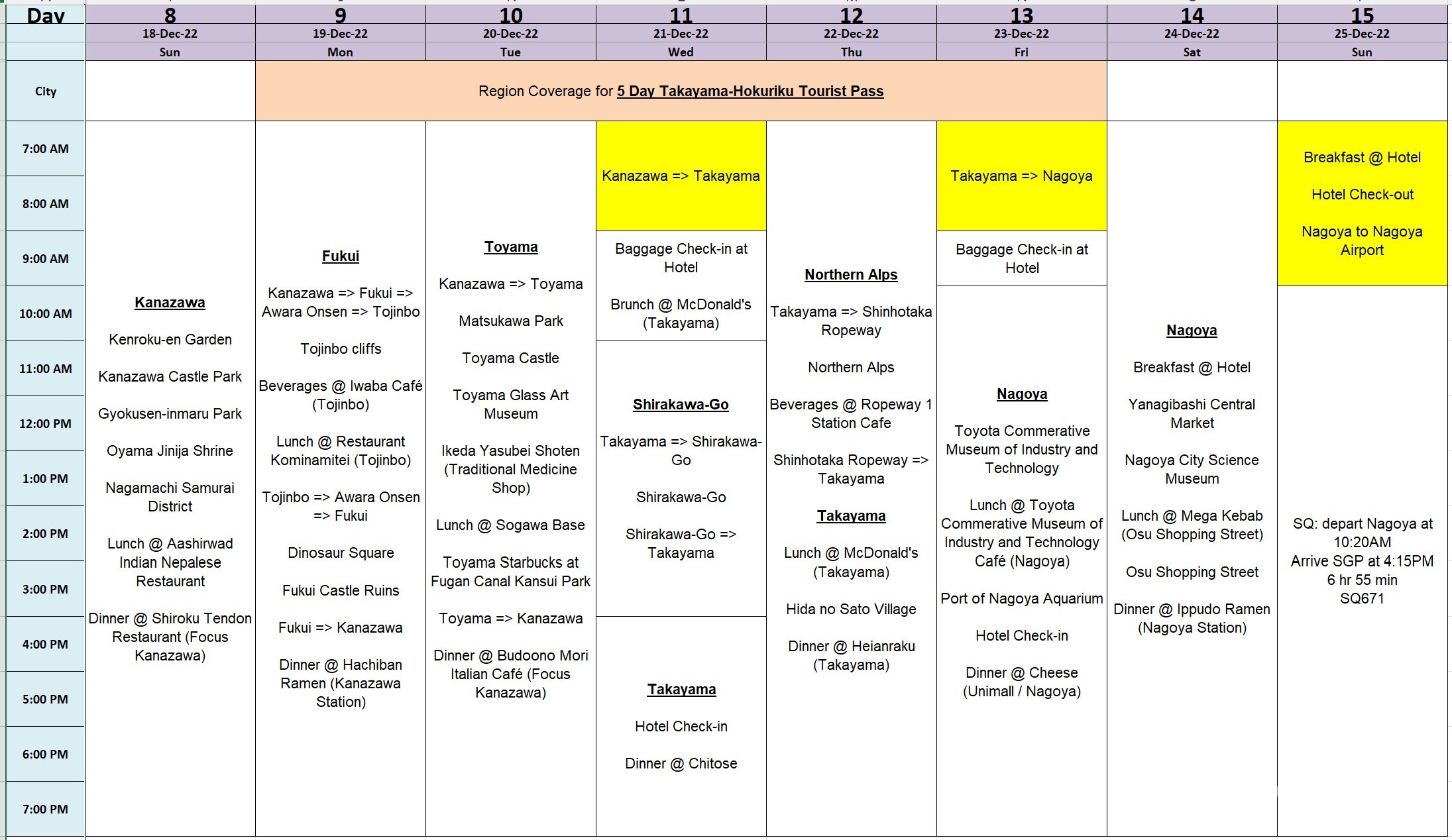
Day 8 (Kanazawa)
Kenroku-en Garden (2 hrs+) [blog post here]: This is one of Japan’s top three landscaped gardens, and we were hoping to be able to visit this famed place and experiencing late autumn colors. What we got was a very different experience: snow hail and rain! But it did make for a very different visual experience compared to the visits to other gardens in the country in our previous visits. The garden is fairly large and you could easily spend 2 hours strolling in it. This garden is also a major tourist spot. But unlike Koraku-en that I visited in 2019, Kenroku-en doesn’t feature the same kind of open garden concept to the same degree: which means you’d be more likely to be able to get photos without too much human traffic. Nonetheless, if congestion bothers you, then this will still be a place that you’d want to time a visit carefully to avoid crowds.
Kanazawa Castle Park (1 hr) [blog post here]: This castle park sits beside Kenroku-en but the bus loads of tourists going to the garden don’t seem to stop by too much at this castle park too much. The castle park is worth a quick look for its two turrets at either side of the storehouse and the large open courtyard in front of it, but you’d likely not spend too much time here. Do definitely spend some time taking a look at the Gyokusen-inmaru Park though – see next.
Gyokusen-inmaru Park(1 hr+) [blog post here]: This is a lovely but small landscaped garden that’s next to Kanazawa Castle Park. The path that winds inside the garden was closed the afternoon we went by, so we could only observe the park from the teahouse. Pictures of the park do make it look like a diorama as it’s really not a big garden, but it’s nonetheless very pretty nonetheless.
Oyama Jinija Shrine (0.5 hr+) [blog post here]: Across the road from Gyokusen-inmaru Park is the Oyama Jinjia Shrine. There is a shrine and a small pond with stone steps in it that’s also worth a quick look.
Nagamachi Samurai District (1 hr) [blog post here]: Another 6-7 minutes walk away from the Shrine is the old Samurai District. For laymen, the traditional houses here are not too visually different from what we saw at the Higashi Chaya District the previous day. But the area also seems to see far less congestion too, so if you’d like a peaceful stroll of traditional wooden houses from the Edo period, this is another option.
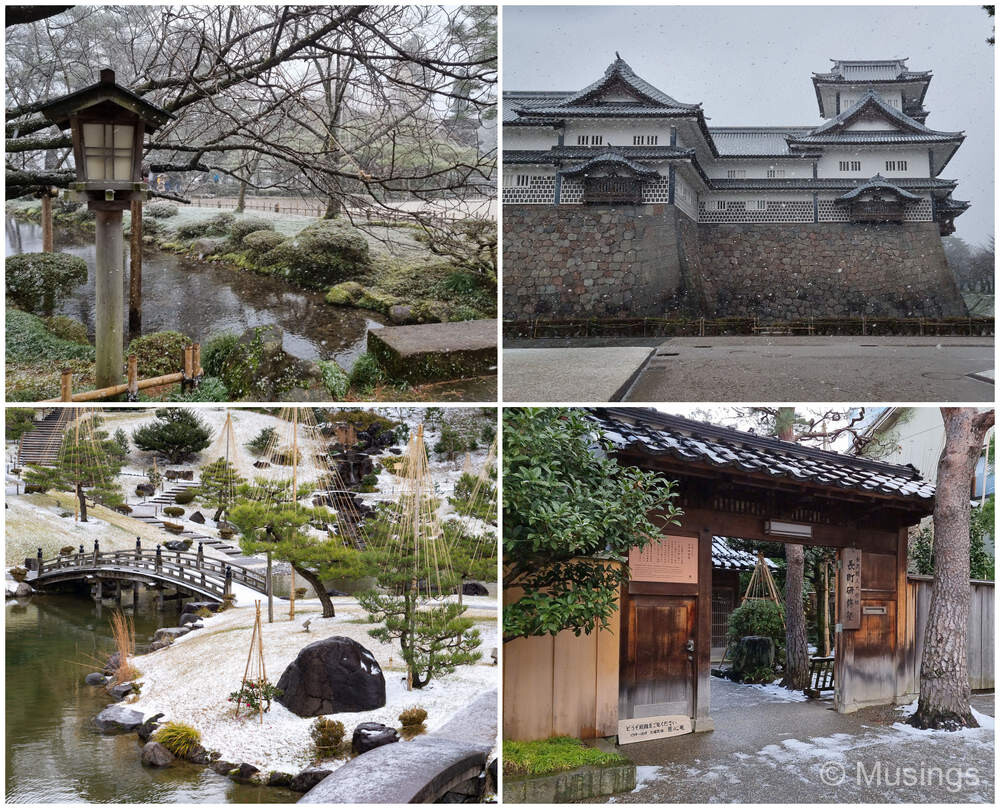
Day 9 (Fukui)
Tojinbo (2 hrs+) [blog post here]: Tojinbo can be reached from Kanazawa through taking a train from Kanazawa Station to Amara Onsen Station, then switching to a 45 minute bus that will take you to Tojinbo, with another bus that can take you back. The one kilometer long stretch of rugged cliffs and the Sea of Japan beyond it is without doubt spectacular, but any visit is also subject to the mercies of weather. We faced snow hail, rain and strong winds the morning we made our way there. The tour boats that will bring you to a close look of these cliffs were not running because of that bad weather, and we were equally hit by the strong winds and rain while walking on the marked out trails themselves too. You’d need to be extra cautious if you’re walking down the trails that lead further down to the cliffs. It looks dangerous enough in good weather – but in wet weather and strong winds, you just might lose your balance and fall into the sea – not before smashing into the rocks that is!
Near to this cliff stretch is also Oshima Island: which we really wanted to also visit but could not do so as the island was closed because of weather.
Fukui Dinosaur Square and Fukui Castle Ruins (1 hr) [blog post here]: The Dinosaur Square is right outside Fukui train station – you’d almost for certain have to go past it to get anywhere on foot from the station. The Square is good for a quick couple of minutes to stop and look at the dinosaurs fixtures and pose for pictures, before you’d inevitably want to move on. The Fukui Castle Ruins is another 5 minutes walk from the Square, and is worth a look for a stone walls and the castle moat – but there isn’t much else there. Earlier versions of our itinerary included a visit to the Fukui Prefecture Dinosaur Museum – but that was closed for the month – and also the Eiheiji Temple, but that was dropped also because of the snowy weather that day in Fukui.
Day 10 (Toyama)
Toyama Castle and Matsukawa Park (1 hrs+) [blog post here]: We had a free day to use for the 5 day pass. One option is to take a day to visit any one of the many onsen towns near Kanazawa, but we didn’t go with that option on account that I wasn’t really keen on onsen experiences. So, we set aside a day to visit Toyama, starting with the Matsukawa Park and the reconstructed castle keep. The castle isn’t big but its interior houses a local history museum. We didn’t enter into the latter, and had the kids occupy themselves with snow play in the courtyard area in the front of the castle. The castle is quite lovely from the outside at least. Do remember to observe the castle from across the pond where the Sato Memorial Museum of Art – it makes for some really pretty picture taking.
Toyama Glass Art Museum (2 hrs) [blog post here]: We wasn’t expecting much from this museum so were iffy about including it ito the itinerary. Boy, were we wrong about that and later glad we stopped by this. The somewhat pricey admission price aside if you want to access the special exhibits, the works in this museum were exquisite! The sixth floor is a permanent exhibition of glass art work by famed American glass artist Dale Chihuly. Even if you don’t have interest in the museum itself, the building where the museum is situated in is visually stunning in itself. The building is also where the Toyama City Public Library is, and the interior’s construction of wood is beautiful. s
Ikeda Yasubei Shoten (0.5 hr) [blog post here]: This Traditional Medicine shop is a few minutes walk from the Glass Art Museum, and can be worth a look if you’re interested in traditional medicines or have an ailment that you want to get consultation on and can speak the language. We’re neither, but since we were in the vicinity went by to take a look. You can skip this if you’re pressed for time and have no interest in this sort of thing.
Starbucks at Fugan Canal Kansui Park (0.5 hr) [blog post here]: The Starbucks that faces the Kansui Park looked glorious from pictures. In non-winter that is! The park felt drained of color the day we went by. But Starbucks is Starbucks, and there’s no reason not to take advantage of the healthy exchange rate from SGD to Japanese Yen and enjoy your Venti drinks that are cheaper in Japan than in Singapore. This Starbucks outlet has al fresco-styled seating on the outside, and the cafe itself is somewhat small.
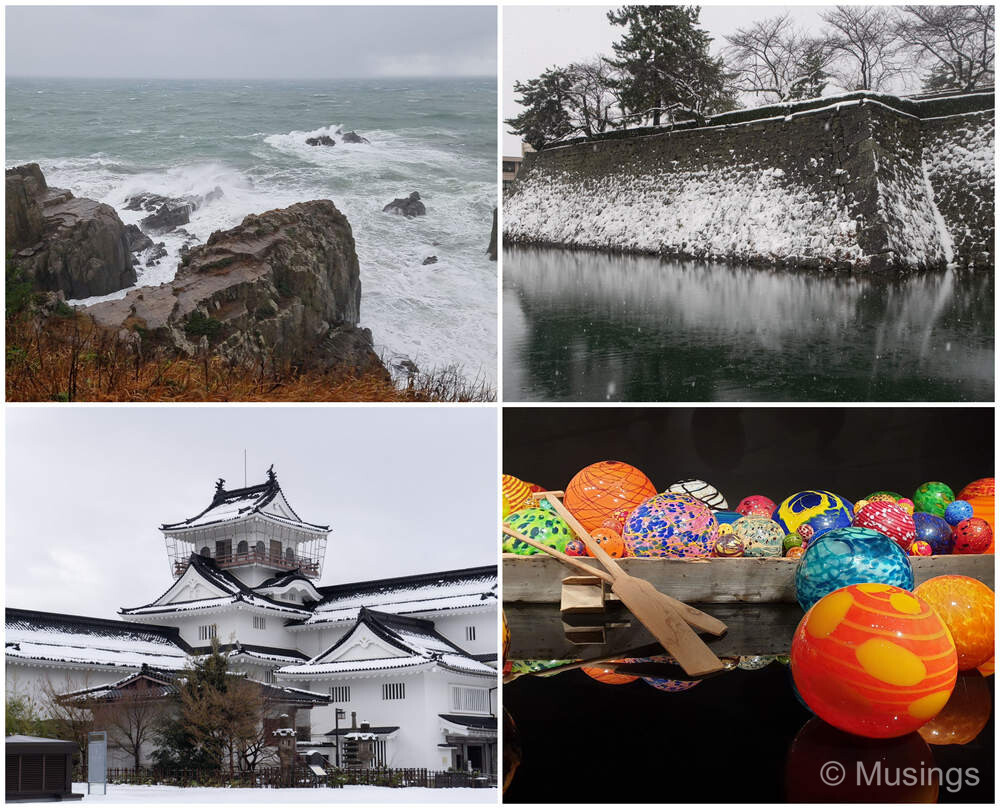
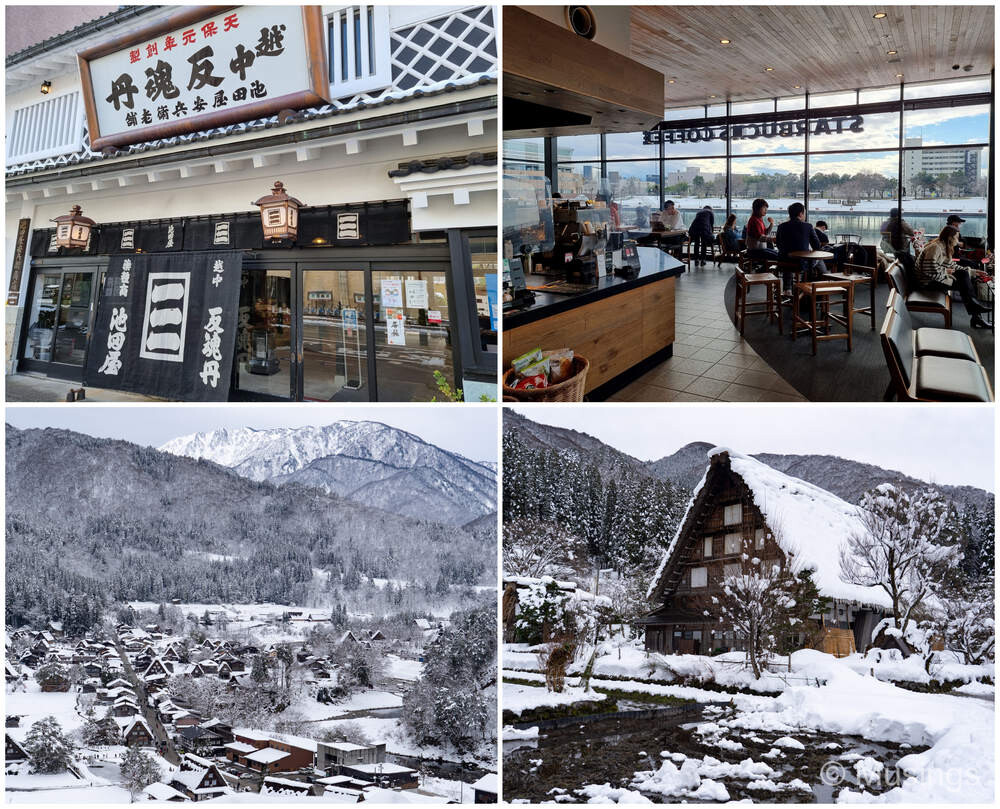
Day 11 (Takayama – Shirakawa-Go)
Shirakawa-Go (3 hrs+) [blog post here]: Between Shirakawa-Go and Hida No Sato Village, try try try to visit both! As much as a learning experience the Hida No Sato village provides for a single admission fee, the view from Shiroyama Viewpoint of the Ogimachi village in Shirakawa-Go is where you can witness that fabulous view and also replicate fairly easily the those touristy pictures of the place. The village is a major tourist attraction, so be mentally prepared for crowds, especially when it’s time for you to leave the place. Do keep in mind then the time of your intended departure from the place, reserve your bus tickets at the village’s information office as needed, and take your time. Do keep in mind that many of the museums in Ogimachi village requires admission charges.
Day 12 (Northern Alps – Takayama)
Northern Alps (2 hrs+) [blog post here]: In another lesson about how winter can easily derail the best planned itinerary, our visit to see Mt. Hotaka via the Shinhotaka Ropeway turned out to be a bust: we were able to ascend only up to Ropeway Station 1 – which doesn’t have that much – as the continuing Ropeway segment to Station 2 was closed because of strong winds. There really wasn’t much to see at Station 1, and as the lifts were still operating at their fixed schedule, we made do with just chilling at the station’s cafe and enjoying their pricey but yummy curry beef pies. We did catch quick looks of the mountain ranges when on the bus journey back to Takayama so it wasn’t a total loss. But if you’re likewise traveling in winter, do try your best to check around to see if the ropeway segments are closed. It will not be easy and might not be even possible given how quickly these things can happen – e.g. the Nohi Takayama Bus Terminal information counter seemed clueless that the summit was closed and sold us the full bus + ropeway combo ticket anyway. So, keep your fingers crossed!
Hida No Sato (2 hrs+) [blog post here]: The Hida No Sato village doesn’t feature the glorious observation vantage viewpoints of Shirakawa-Go, but for the price of a single admission, the compound’s 30 traditional houses is opened to you for exploration. The houses were relocated from around the Gifu prefecture around Takayama to create this open-air museum in 1971, and is well worth your spending a few hours to visit and learn about the lifestyles and work of the Hida people. The village is within easy reach from Nohi Takayama Bus Terminal and the bus runs pretty frequently. Go for it!
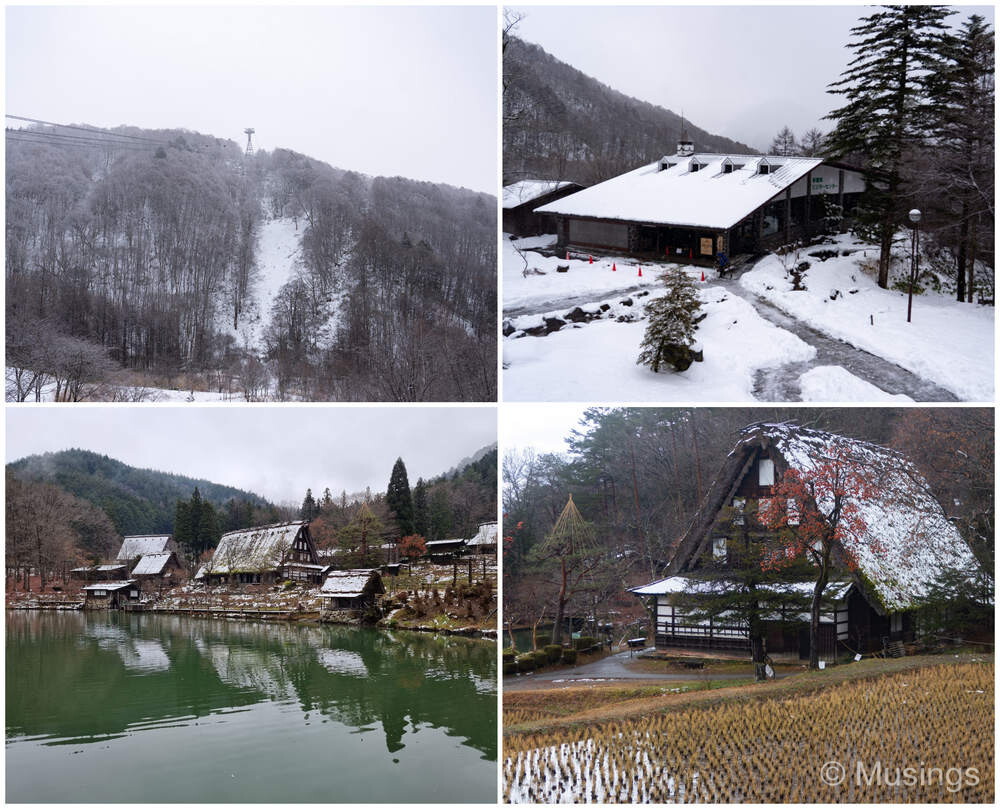
Day 13 (Takayama – Nagoya)
Toyota Commemorative Museum of Industry and Technology (3 hrs+) [blog post here]: This museum has been widely praised for how it’s been put together as a learning experience to understand the importance of one of Japan’s most famous companies – Toyata – and how it began as a textile machinery manufacturer to today as a technology powerhouse. The demonstrations are timed carefully so that you can in a single period enjoy the hosted exhibitions, with time in-between to explore on your own too. The staff are also really friendly, and will even approach you to help if you look lost or uncertain for even a brief moment. We spent 2.5 hours here, and didn’t feel even then that we’d really explored everything in this museum.
Port of Nagoya Aquarium (2.5 hrs+) [blog post here]: One of Japan’s better public aquarium. The interiors and themed tanks aren’t quite where the modern or refurbished aquariums elsewhere in the world, but the shows here at this Nagoya aquarium are spectacular, and the dolphins and Orcas perform in large water tanks. The Otaru Aquarium which we last visited in 2019 had a much smaller performance area – which made it easier to guess where the next show act will be, and is also indoor – which provided some protection against the weather. The Nagoya Aquarium is in an open-air but sheltered overhead stadium, and it was really chilly the afternoon we visited and saw the shows. There is an interesting pearl harvesting experience for ¥1,000 that our daughter asked to take part, and she came out of that with a pearl necklace.
Day 14 (Nagoya)
Yanagibashi Central Market (1 hrs) [blog post here]: I reckon this fresh seafood and produce market won’t be on most visitor’s itinerary. But it’s pretty near Nagoya Station, and if you’re looking to visit one while in the city and want one that’s within easy reach, this could be it. Just be mindful – as with all markets – that this place isn’t really geared towards tourists, unlike the Tsukiji Outer Market in Tokyo that we visited in 2019. You can tell from its relative absence from street food stalls and also restaurants. So, if you’re visiting, keep in mind not to be a hindrance to the stall and shopkeepers and locals as they go about their daily business in the market.
Nagoya City Science Museum (4 hrs+) [blog post here]: This was a great visit for us: the museum has multiple levels of exhibits, and they are organized by discipline. We spent 3 hours here, and didn’t see and experience everything the museum had to offer. Some major caveats though: the museum is designed for the locals, not tourists – which means that there is a relative lack of language support for anything not Japanese. We were still able to scrape through on account that some of the interactive exhibits were easy enough to figure out it’s intended purpose. Moreover, the missus is a science teacher, so she instinctively recognized many of the underlining scientic principles showcased in the exhibits. The Planetarium presentation was also a major disappointment for us, so if you do not understand Japanese, don’t bother with the Planetarium then and save yourself the money.
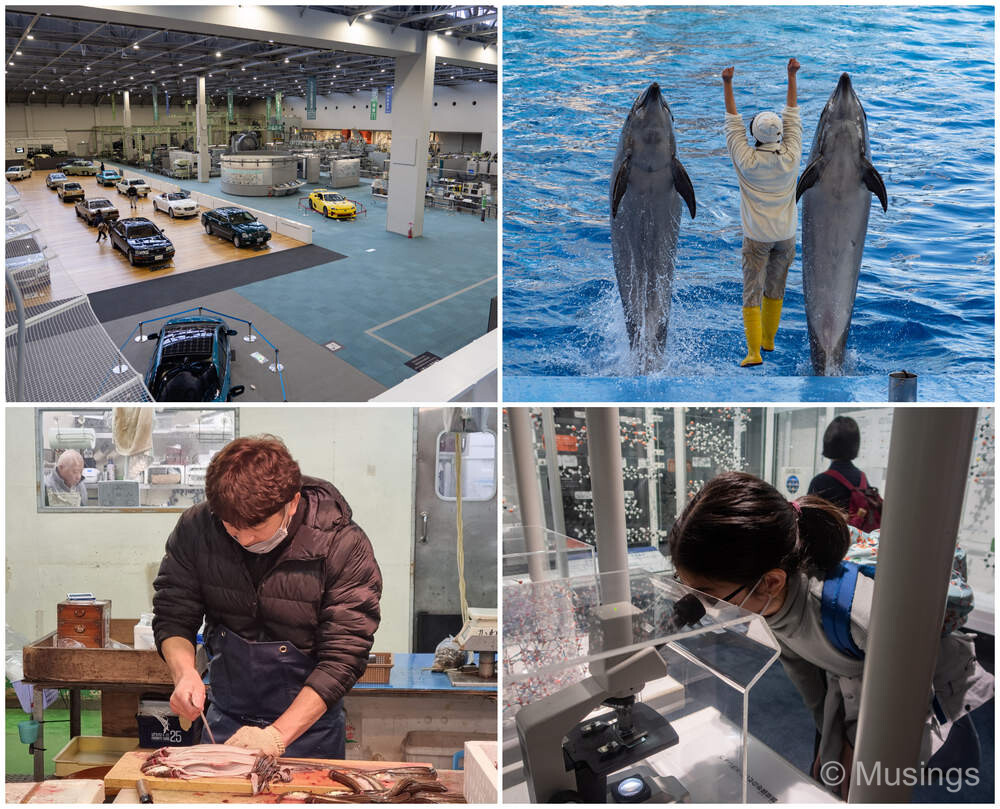
Day 15 (Nagoya)
Flight home to Singapore (6 hrs 55 mins).
—-
And my quick categorization of sights into “Must see/visit”, “Fairly good places”, “OK to skip/Use as filler” categories:
| Category | Places |
|---|---|
| Must see/visit | Nara Deer Park, Kobe Herb Garden, Koko-en Garden, Arashiyama Bamboo Forest, Kenroku-en Garden, Toyama Glass Art Museum, Shirakawa-Go, Hida no Sato Village, Toyota Commemorative Musuem of Industry and Technology, Nagoya City Science Museum. |
| Fairly good places | Philosopher’s Walk, Yoshikien Garden, Todaji,Uji-Bashi Bridge, Byondo-in Street, Uji Prefecture Park, Kobe Animal Kingdom, Engyoji Temple, Himeji Castle, Osaka Aquarium Kaiyukan, Osaka Castle Park, Fushimi Inari Shrine, Gion, Higashi Chaya District, Kazue-machi Chaya District, Kanazawa Castle Park, Gyokusen-inmaru Park, Oyama Jinija Shrine, Tojinbo Cliffs, Northern Alps, Port of Nagoya Aquarium |
| OK to skip/Use as filler | Nagamachi Samurai District, Fukui Dinosaur Square, Fukui Castle Ruins, Toyama Castle and Matsukawa Park, Ikeda Yasubei Shoten, Toyama Starbucks at Fugan Canal Kansui Park, Yanagibashi Central Market |
That’s it for our itinerary and visitation notes, as it was realized in the actual trip. Of note again is that we didn’t get to visit Oshima Island nor reach the summit to see Mt. Hotaka. We also Eiheji temple at Fukui, and also were contend to observe various castles – e.g. at Kanazawa, Toyama and Osaka – from just the outside.
Next post will be on interesting flora that we saw in Japan!